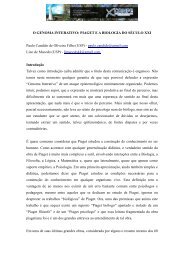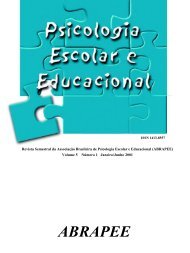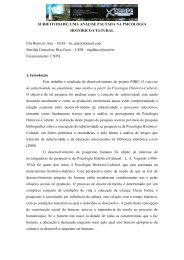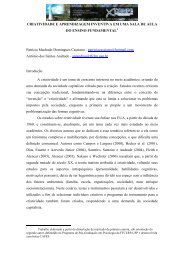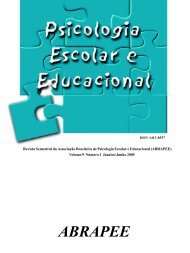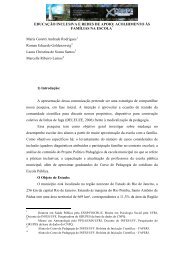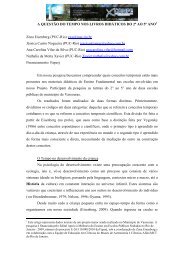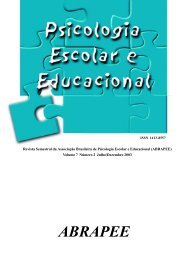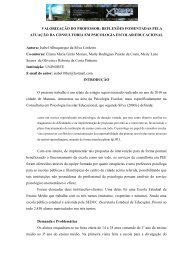Livro Psic. escolar e educ - Para associar-se ou renovar sua ...
Livro Psic. escolar e educ - Para associar-se ou renovar sua ...
Livro Psic. escolar e educ - Para associar-se ou renovar sua ...
- No tags were found...
Create successful ePaper yourself
Turn your PDF publications into a flip-book with our unique Google optimized e-Paper software.
Determinantes psicolingüísticos da compreensão de leitura em inglês como língua estrangeira 29actually have is a rather indirect effect of tho<strong>se</strong> variablesa two-pha<strong>se</strong> model which is explained as follows:PHASE 1Reading comprehension in Spanish is a function ofthe reader’s cognitive style, locus of control, and actioncontrol orientation. Model 3PHASE 2Reading comprehension in English is a function ofthe reader’s level of reader comprehension in Spanish,linguistic competence in English, and ability to perceivelexical transparency between L1 and L2. Model 2DISCUSSION AND CONCLUSIONSThe main re<strong>se</strong>arch hypothesis of this study was thatthat the variation in reading comprehension in English inMexican university students was a function of theinteraction of both linguistic variables (text processingstrategies in L1, linguistic competence in L2 and perceptionof lexical transparency between L1 and L2) andpsychological variables (cognitive style, locus of controland action control). However, and even th<strong>ou</strong>gh theinfluence of the aforementioned variables was partiallyvalidated from the <strong>se</strong>ries of regression analy<strong>se</strong>s performed,it became evident that the explanation of the variability inreading comprehension in L2 was not straightforward (i.e.,one that c<strong>ou</strong>ld be acc<strong>ou</strong>nted for on the basis of the directcontribution of the complete <strong>se</strong>t of originally propo<strong>se</strong>dvariables). Rather, such variability was partially explainedon the basis of a two-stage process in which the influenceof the three linguistic variables integrated into the modelshowed to be direct, whereas the influence of the threepsychological variables was indirect (Figure 2).Figure 2: A preliminary explanatory model of text processingvariability in English (L2).Specifically, and as originally hypothesized, thereaders’ ability to process academic written disc<strong>ou</strong>r<strong>se</strong>in English has shown to be a function of three majorpredictor variables, namely, reading comprehension inSpanish, linguistic competence in the foreign language,and ability to perceive lexical transparency between thetwo languages. In such regard, a model has beenvalidated that acc<strong>ou</strong>nts for an initial 35% of the varianceof reading comprehension in English taking as predictorvariables the three linguistic variables incorporated intothe original model. On the other hand, and even th<strong>ou</strong>ghthe <strong>se</strong>t of psychological variables did not show a direct,significant contribution in the explanation of readingcomprehension in English, an alternative multipleregression analysis, which considered the readers’ textprocessing strategies in L1 as the dependent variable,revealed that the reader’s cognitive style, locus of controland action control orientation have a slight, th<strong>ou</strong>ghsignificant contribution, in the explanation of the variabilityof text processing strategies in L1. Hence, given thefact that reading comprehension in Spanish constitute in<strong>ou</strong>r model the most important predictor of the variabilityassociated with disc<strong>ou</strong>r<strong>se</strong> processing in English, and thatthe former is in it<strong>se</strong>lf partially explained by the complete<strong>se</strong>t of psychological variables, a two-stage explanatorymodel of reading in LLL2 is suggested from this studyba<strong>se</strong>d on the following considerations.First, it has been f<strong>ou</strong>nd that the ability of the readerto process written academic disc<strong>ou</strong>r<strong>se</strong> in L1 is the mostpowerful predictor of his/her reading comprehension inthe foreign language, maybe in the form of the metamodelof language propo<strong>se</strong>d by Beaugrande (1984)paving the way for the extrapolation of reading strategiesfrom L1 to L2. Second, text processing skills in Englishhave also been explained by the reader’s level oflinguistic competence in the foreign language,competence that w<strong>ou</strong>ld repre<strong>se</strong>nt the linguisticknowledge ba<strong>se</strong> of the reader and that w<strong>ou</strong>ld play amajor role in the successful construction of meaning fromtext. Third, the ability to perceive and exploit lexicaltransparency between L1 and L2 has also been f<strong>ou</strong>ndto constitute a determinant of text processing ability inthe foreign language.Furthermore, it has been f<strong>ou</strong>nd that cognitive style,locus of control, and action control orientation function asindirect psychological mediators of reading comprehensionin English, exerting an indirect impact on such variablevia their influence on the reader’s disc<strong>ou</strong>r<strong>se</strong> processing<strong>Psic</strong>ologia Escolar e Educacional, 2003 Volume 7 Número 1 21-31



